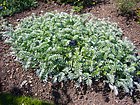Note: This is a project under development. The articles on this wiki are just being initiated and broadly incomplete. You can Help creating new pages.
Difference between revisions of "Potentilla anserina - Silverweed"
(→Photo Gallery) |
(→Identification) |
||
| (8 intermediate revisions by 2 users not shown) | |||
| Line 35: | Line 35: | ||
==Identification== | ==Identification== | ||
===Leaf=== | ===Leaf=== | ||
| − | {{Leaf|Simple| | + | {{Leaf|Simple|Compound|Leaf arrangement is basal i.e the leaves are growing only at the base of the plant}}<ref name="Leaf"/> |
===Flower=== | ===Flower=== | ||
| Line 41: | Line 41: | ||
===Fruit=== | ===Fruit=== | ||
| − | {{Fruit|General|Up to 2.5 mm| | + | {{Fruit|General|Up to 2.5 mm|The fruit is dry but does not split open when ripe|With hooked hairs|Many}} |
===Other features=== | ===Other features=== | ||
==List of Ayurvedic medicine in which the herb is used== | ==List of Ayurvedic medicine in which the herb is used== | ||
| − | |||
==Where to get the saplings== | ==Where to get the saplings== | ||
| Line 64: | Line 63: | ||
File:Argentina anserina 4.JPG|<center>Leaves</center> | File:Argentina anserina 4.JPG|<center>Leaves</center> | ||
File:Potentilla anserina 001.JPG|<center>Whole herb</center> | File:Potentilla anserina 001.JPG|<center>Whole herb</center> | ||
| + | File:Aran7 002 lhp.jpg|Seed | ||
| + | File:Potentilla anserina 'silver weed' 2007-06-02 (plant).jpg|Whole plant | ||
</gallery> | </gallery> | ||
| Line 69: | Line 70: | ||
<references> | <references> | ||
| − | <ref name="chemical composition">[https://www.researchgate.net/publication/235927094_Chemical_diversity_of_silverweed_Potentilla_anserina_L_growing_at_the_edges_of_arable_fields_Plant_Breeding_And_Seed_Science | + | <ref name="chemical composition">[https://www.researchgate.net/publication/235927094_Chemical_diversity_of_silverweed_Potentilla_anserina_L_growing_at_the_edges_of_arable_fields_Plant_Breeding_And_Seed_Science Chemical diversity]</ref> |
| − | <ref name="Leaf">[https://gobotany.newenglandwild.org/species/argentina/anserina/ | + | <ref name="Leaf">[https://gobotany.newenglandwild.org/species/argentina/anserina/ Characteristics]</ref> |
| − | <ref name="How to plant/cultivate">[https://pfaf.org/user/Plant.aspx?LatinName=Argentina+anserina | + | <ref name="How to plant/cultivate">[https://pfaf.org/user/Plant.aspx?LatinName=Argentina+anserina Cultivation details]</ref> |
</references> | </references> | ||
| Line 82: | Line 83: | ||
* [http://www.mdpi.com/1420-3049/20/1/224/htm Phenolic Profile of Potentilla anserina L] | * [http://www.mdpi.com/1420-3049/20/1/224/htm Phenolic Profile of Potentilla anserina L] | ||
[[Category:Herbs]] | [[Category:Herbs]] | ||
| + | [[Category:Rosaceae]] | ||
Latest revision as of 17:05, 16 July 2020
Argentina anserina is a synonym of Potentilla anserina L. the accepted name of a perennial flowering plant in the rose family Rosaceae. It is known by the common names silverweed, common silverweed or silverweed cinquefoil. It is native throughout the temperate Northern Hemisphere, often on river shores and in grassy habitats such as meadows and road-sides.
Contents
- 1 Uses
- 2 Parts Used
- 3 Chemical Composition
- 4 Common names
- 5 Properties
- 6 Habit
- 7 Identification
- 8 List of Ayurvedic medicine in which the herb is used
- 9 Where to get the saplings
- 10 Mode of Propagation
- 11 How to plant/cultivate
- 12 Commonly seen growing in areas
- 13 Photo Gallery
- 14 References
- 15 External Links
Uses
Piles, Diarrhoea, Ulcers, Haemorrhoids, Painful area, Sore throats.
Parts Used
Chemical Composition
he tannin content was very low (0.81-0.91%). The total flavonoid content ranged from 0.48 to 0.60%. Phenolic acid content was much higher (1.38-2.26%)[1]
Common names
| Language | Common name |
|---|---|
| Kannada | |
| Hindi | |
| Malayalam | |
| Tamil | |
| Telugu | |
| Marathi | NA |
| Gujarathi | NA |
| Punjabi | NA |
| Kashmiri | NA |
| Sanskrit | |
| English | Silverweed, Argentine, Crampweed, Goosewort, Moon grass |
Properties
Reference: Dravya - Substance, Rasa - Taste, Guna - Qualities, Veerya - Potency, Vipaka - Post-digesion effect, Karma - Pharmacological activity, Prabhava - Therepeutics.
Dravya
Rasa
Tikta (Bitter), Kashaya (Astringent)
Guna
Laghu (Light), Ruksha (Dry), Tikshna (Sharp)
Veerya
Ushna (Hot)
Vipaka
Katu (Pungent)
Karma
Kapha, Vata, Pitta
Prabhava
Habit
Identification
Leaf
| Kind | Shape | Feature |
|---|---|---|
| Simple | Compound | Leaf arrangement is basal i.e the leaves are growing only at the base of the plant |
Flower
| Type | Size | Color and composition | Stamen | More information |
|---|---|---|---|---|
| Unisexual | 2-4cm long | Yellow | 13 | Flowers Season is June - August |
Fruit
| Type | Size | Mass | Appearance | Seeds | More information |
|---|---|---|---|---|---|
| General | Up to 2.5 mm | The fruit is dry but does not split open when ripe | With hooked hairs | Many | {{{6}}} |
Other features
List of Ayurvedic medicine in which the herb is used
Where to get the saplings
Mode of Propagation
How to plant/cultivate
A very easily grown plant, succeeding in almost any soil, thriving in moist clays, though rather dwarfed in dry dusty soils[4]. It grows best in a well-drained loam, preferring a position in full sun but tolerating shade[3]
Commonly seen growing in areas
Ditches, Moist calcareous soils.
Photo Gallery
References
External Links
- Ayurvedic Herbs known to be helpful to treat Piles
- Ayurvedic Herbs known to be helpful to treat Diarrhoea
- Ayurvedic Herbs known to be helpful to treat Ulcers
- Ayurvedic Herbs known to be helpful to treat Haemorrhoids
- Ayurvedic Herbs known to be helpful to treat Painful area
- Ayurvedic Herbs known to be helpful to treat Sore throats
- Herbs with Roots used in medicine
- Herbs with Leaves used in medicine
- Herbs with common name in English
- Habit - Perennial herb.
- Index of Plants which can be propagated by Seeds
- Index of Plants which can be propagated by Cuttings
- Herbs that are commonly seen in the region of Ditches
- Herbs that are commonly seen in the region of Moist calcareous soils
- Herbs
- Rosaceae






